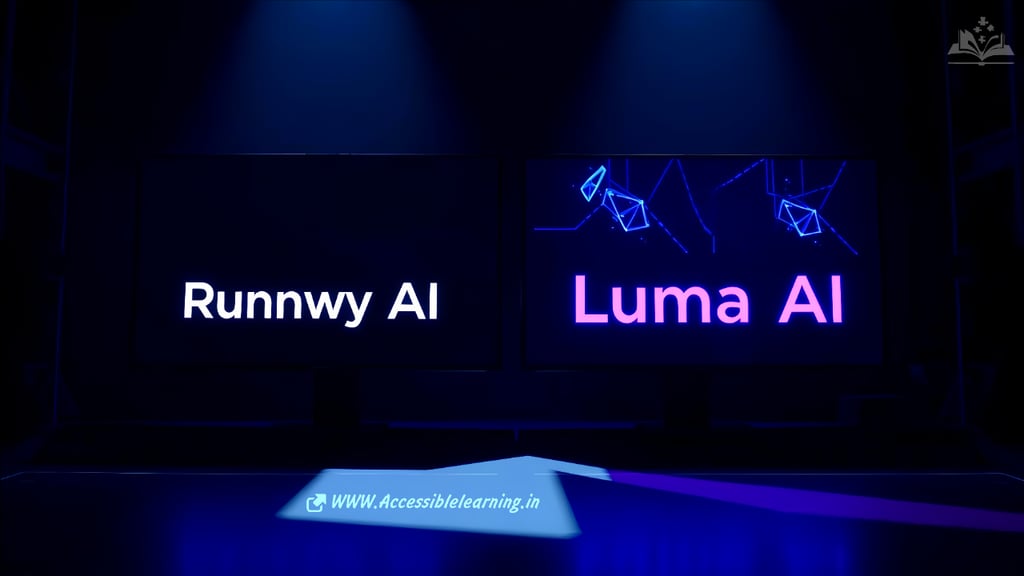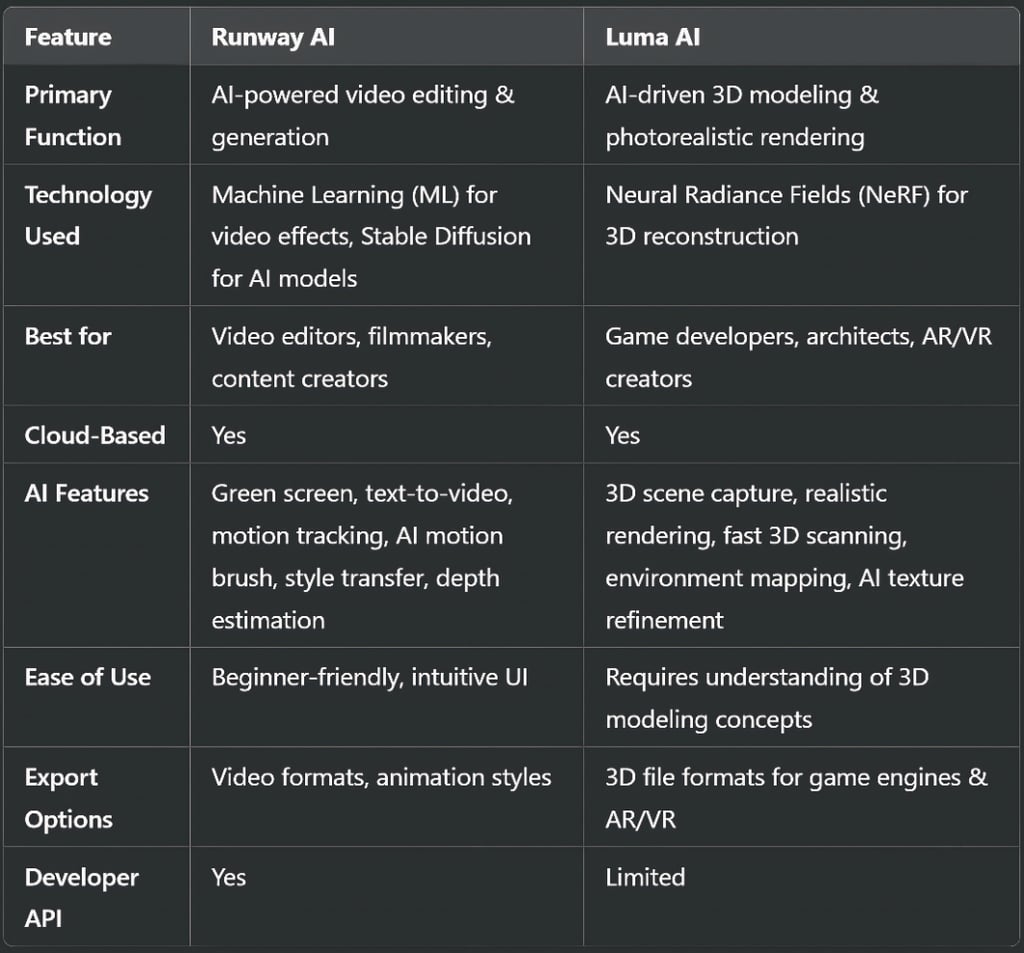
Runway AI vs. Luma AI: Features, Differences, and Best Use Cases
Explore the in-depth comparison between Runway AI and Luma AI, two leading AI tools in creative technology. Learn about their features, differences, and ideal use cases to determine which one best suits your needs for video editing or 3D content creation.
AI ASSISTANTAI/FUTUREEDITOR/TOOLSAI ART TOOLSARTIST/CREATIVITY
Sachin K Chaurasiya
3/4/20254 min read


The rise of AI-driven creativity has transformed the way content is generated, edited, and optimized. Two major players leading this revolution are Runway AI and Luma AI. While both offer powerful tools for visual content creation, they serve different purposes. In this in-depth comparison, we’ll explore their features, differences, and ideal use cases to help you choose the best tool for your needs.
What is Runway AI?
Runway AI is an AI-powered creative toolkit designed for video editing, generative AI models, and real-time visual effects. It is widely used in filmmaking, content creation, and artistic endeavors. The platform offers an intuitive, web-based interface, enabling users to generate videos, remove backgrounds, and apply AI-driven effects with ease.
Key Features
Text-to-Video Generation: Users can generate short AI-powered videos from simple text prompts.
AI-Powered Video Editing: Runway offers tools like Green Screen (background removal), Motion Tracking, and Object Removal.
Generative Models: Supports Stable Diffusion-based models and other AI-powered tools for art and video synthesis.
Collaboration & Cloud-Based Editing: Ideal for teams working remotely on creative projects.
Live Video Processing: Enables real-time application of AI-powered effects.
AI Motion Brush: Allows for selective motion control in videos, enabling more refined adjustments.
Style Transfer: Users can apply AI-generated artistic styles to videos for unique visual effects.
Text-Based Video Editing: Enables video edits by simply modifying text, making the process efficient and seamless.
AI Super-Slow Motion: Enhances low-frame-rate videos using AI to generate intermediate frames smoothly.
Auto Subtitling & Transcription: Uses AI to generate subtitles automatically with high accuracy.
Depth Estimation & 3D Effects: Allows creators to simulate 3D effects from 2D videos.
Integration with Python SDK & API: Developers can automate and integrate AI video editing into workflows.
Technical Aspects
Uses Stable Diffusion, GANs (Generative Adversarial Networks), and Transformer models for AI-generated content.
Supports CUDA-based GPU acceleration for faster AI processing.
Cloud-based architecture ensures scalability and accessibility from any device.
Compatible with major video formats, including MP4, MOV, and GIF exports.
Features multi-frame interpolation algorithms for smooth animation generation.
Strengths
AI-Powered Video Editing: Offers advanced tools like background removal, motion tracking, and text-to-video generation.
User-Friendly Interface: Intuitive and beginner-friendly, making AI-driven video editing accessible.
Cloud-Based Processing: No need for high-end hardware, as everything is processed online.
Real-Time Effects: Enables quick application of AI effects for seamless video creation.
Collaboration Features: Supports team projects and remote workflows.
Weaknesses
Limited to Video Editing: Lacks support for 3D modeling or AR/VR applications.
Rendering Limitations: High-resolution exports may require additional processing time.
Subscription-Based Pricing: Some advanced features require a paid plan.
Not for Professional VFX: While useful, it may not fully replace professional-grade video editing software like Adobe After Effects.
Ideal Use Cases
Filmmakers are looking for AI-driven post-production tools.
Social media content creators want quick AI-based edits.
Artists and designers are exploring AI-generated visuals.
Businesses looking to create marketing videos efficiently.
Educators who need visual aids and quick video edits.
Developers are integrating AI video generation into applications.
What is Luma AI?
Luma AI, on the other hand, focuses on 3D content creation using AI-powered photorealistic rendering and 3D scene reconstruction. It specializes in NeRF (Neural Radiance Fields) technology, which allows users to capture real-world objects and environments and convert them into highly detailed, interactive 3D models.
Key Features
NeRF-Based 3D Capture: Creates ultra-realistic 3D models from simple video captures.
AI-Powered Photorealism: Produces high-quality textures, lighting, and depth.
Immersive AR & VR Integration: Ideal for game developers, architects, and product designers.
Cloud-Based Processing: 3D models are processed on Luma AI’s cloud servers for high fidelity and accuracy.
Supports Multiple Platforms: Can be used with Unreal Engine, Blender, and AR applications.
Fast 3D Scanning: Provides rapid and accurate 3D scanning capabilities using mobile devices.
Real-Time Environment Mapping: Allows for dynamic mapping of real-world environments for digital applications.
3D Model Export & Editing: Users can export models to various formats and refine them in 3D editing software.
High-Fidelity Mesh Generation: Converts NeRF captures into polygon-based models suitable for games and CGI.
AI-Based Texture Refinement: Uses deep learning to enhance textures for photorealism.
Integration with Game Engines: Compatible with Unity, Unreal Engine, and Blender.
Multi-Angle Object Capture: Ensures 360-degree accurate 3D scanning.
Technical Aspects
Neural Radiance Fields (NeRFs) are utilized for photorealistic 3D reconstructions.
Uses Ray Tracing and Volume Rendering for realistic light interactions.
Compatible with GLTF, OBJ, FBX, and USD file formats for export.
Cloud processing with AI acceleration to enhance model detail and realism.
Supports LiDAR scanning enhancements for added precision.
Strengths
Photorealistic 3D Capture: Uses NeRF technology to create highly detailed 3D models.
Fast and Efficient: Converts real-world objects into digital assets quickly.
Supports AR/VR Development: Ideal for game developers, architects, and immersive media creators.
Cross-Platform Integration: Compatible with Blender, Unreal Engine, and other 3D software.
High-Quality Outputs: Delivers professional-grade 3D assets with accurate lighting and textures.
Weaknesses
Steeper Learning Curve: Requires basic knowledge of 3D modeling and rendering.
Hardware Dependency: Though cloud-based, high-quality 3D processing may need powerful devices.
Limited Editing Tools: Lacks comprehensive post-processing features compared to traditional 3D software.
Performance Variability: 3D model quality depends on the input data (lighting, camera angles, etc.).
Ideal Use Cases
Game developers needing detailed, real-world 3D assets.
Architects and designers requiring accurate visualizations of real-world environments.
AR/VR developers working on immersive digital experiences.
Product designers seeking realistic digital prototypes.
Content creators integrate 3D elements into videos and visual storytelling.
Researchers are using 3D modeling for digital twin simulations.


Which One Should You Choose?
Choosing between Runway AI and Luma AI depends on your creative needs.
If you work with video editing, special effects, or generative AI for media production, Runway AI is the best choice.
If you need high-quality 3D modeling, realistic scene reconstruction, or AR/VR integration, Luma AI is the better option.
If your project requires both 3D and video editing capabilities, using both tools in combination might be beneficial.
Both Runway AI and Luma AI are groundbreaking in their respective domains. Runway AI is perfect for video editors and content creators looking to leverage AI for visual storytelling, while Luma AI is ideal for those who require highly realistic 3D scene captures. Understanding your creative goals will help you pick the right tool to enhance your workflow.
If you're involved in filmmaking, content creation, or digital marketing, Runway AI should be your go-to choice. However, if you're in game development, architectural visualization, or immersive media, Luma AI will better serve your needs.

Subscribe to our newsletter
All © Copyright reserved by Accessible-Learning
| Terms & Conditions
Knowledge is power. Learn with Us. 📚


